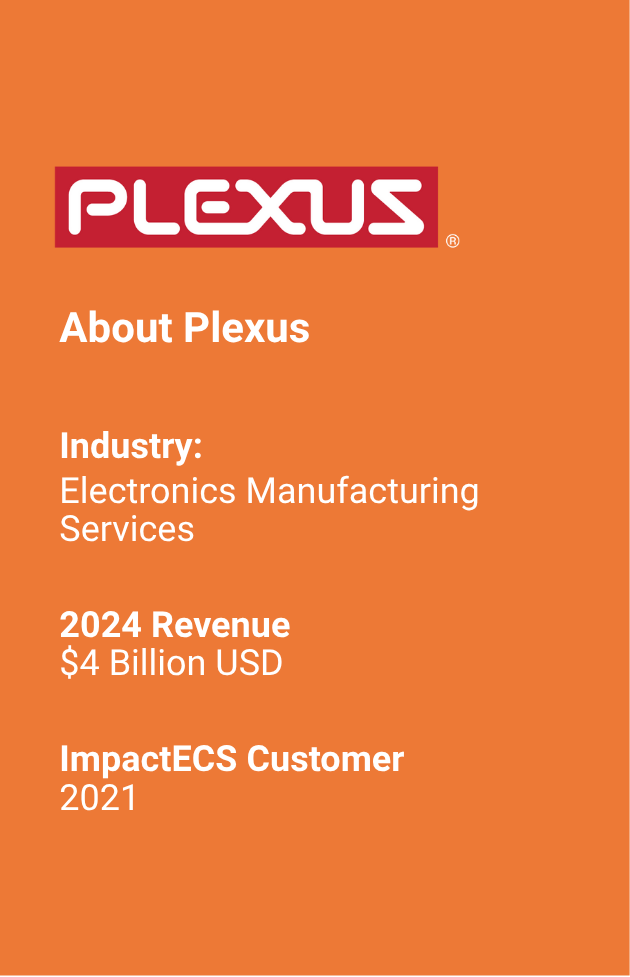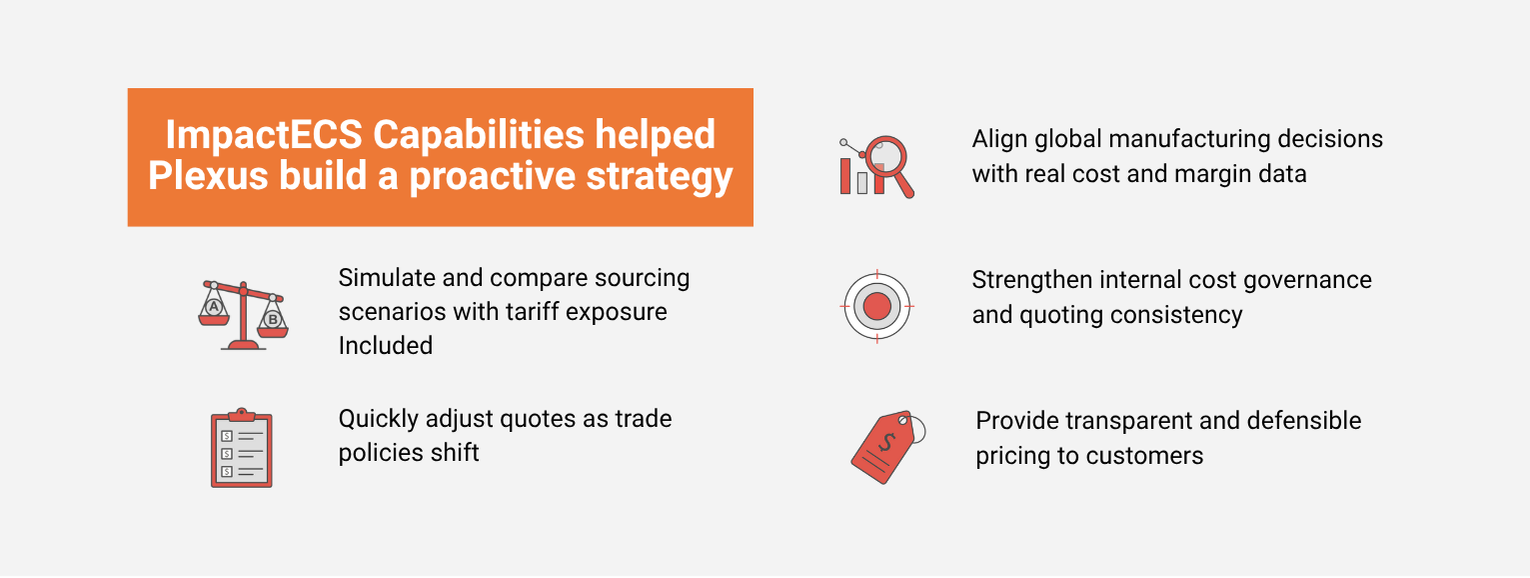From Trade Uncertainty to Cost Clarity: Tariff Scenario Planning at Plexus
As global trade dynamics shift and tariffs continue to reshape supply chains, electronics manufacturing service providers like Plexus are under pressure to respond quickly, quote competitively, and maintain margins in a volatile cost environment. With operations across multiple geographies and a complex bill of materials for each product, understanding how trade policies affect cost-to-serve is no small task.
Understanding the Impact of Tariffs in Electronics Manufacturing
In recent years, electronics manufacturing service providers have faced increasing tariff pressures—particularly from U.S.-China trade tensions, shifting free trade agreements, and region-specific duties on key components and raw materials like semiconductors, aluminum as well as finished goods. For companies like Plexus, which sources components globally and assembles products across a global manufacturing network, even small changes in tariff structures can have a ripple effect on product cost.
Tariffs not only raise direct costs but also force decisions about where to manufacture, how to source components, and how to price final assemblies for customers in different regions. To navigate this complexity, Plexus turned to ImpactECS, a cost and profitability modeling platform, to bring clarity to these cost drivers and integrate tariff scenarios directly into their quoting process.
Cost-Based Quoting with ImpactECS: A Strategic Foundation
Cost-based quoting allows companies to build price proposals using real operational and financial data—factoring in materials, labor, overhead, logistics, and now, trade-related costs like tariffs. Unlike market-based or margin-back pricing approaches, cost-based quoting ensures prices reflect the true economics of delivering the product, providing both internal confidence and external transparency.
Plexus uses ImpactECS as the engine for this process, modeling every cost component that goes into their assemblies. The system allows them to simulate changes in input prices, regional labor differences, and external cost drivers, like tariffs, with precision.
How Plexus Enhanced Their Quoting Model for Tariff Visibility
- Regional Labor Cost Simulator: Plexus developed a labor cost simulator to evaluate how different manufacturing locations impact unit cost. For example, if relocating production from Southeast Asia to Mexico increases unit costs by 15%, they can compare this to the tariff-inclusive landed cost of importing from the original location. This analysis supports strategic decisions on plant utilization, sourcing, and customer pricing.
- Tariff-Adjusted Landed Cost Calculation: Tariffs often apply to specific components rather than finished goods. Plexus enhanced their model to calculate revised landed costs by applying tariff rates at the raw material or component level. This level of granularity enables accurate costing—even when a single component in a multi-part assembly is subject to a new duty.
- Configurable Tariff Presentation in Customer Quotes: Customers often have different preferences when reviewing pricing proposals. To accommodate this, Plexus added functionality to customize how tariffs appear in quotes—whether bundled into the material cost or broken out as a separate line item. This flexibility supports transparent communication and builds trust.
Strategic Outcomes: Visibility, Agility, and Confidence in a Shifting Cost Landscape
With the enhancements to their ImpactECS cost-based quoting model, Plexus isn’t just reacting to tariffs—they’re building a proactive strategy that strengthens customer relationships, improves operational decision-making, and protects profitability. These capabilities matter now more than ever, as manufacturing leaders are called to respond faster and smarter to a constantly changing global trade environment.
- Simulate and compare sourcing scenarios with tariff exposure included: Plexus can evaluate “what-if” scenarios across different manufacturing regions, factoring in both operational costs and tariff implications. This is critical for assessing the full landed cost, not just labor or material expenses, when considering new production locations or suppliers. These simulations help the team make confident, data-backed decisions on where and how to build products without compromising margin targets.
- Quickly adjust quotes as trade policies shift: When tariff rates change or new duties are introduced, Plexus doesn’t have to rebuild models from scratch. Instead, they can update inputs and generate revised quotes in real time. This speed and flexibility is essential in today’s environment, where price agility is often the difference between winning and losing a bid.
- Provide transparent and defensible pricing to customers: With the ability to show tariff impacts as a separate line item or embed them into material costs, Plexus can tailor price proposals to meet customer expectations. This transparency builds trust, reduces pricing disputes, and positions Plexus as a strategic partner.
- Align global manufacturing decisions with real cost and margin data: By connecting tariff implications to actual cost structures across regions, Plexus ensures that operational decisions like shifting production to a new site are grounded in financial reality. It’s not just about minimizing cost; it’s about optimizing for profitability across the entire supply chain.
- Strengthen internal cost governance and quoting consistency: With a centralized model inside ImpactECS, Plexus ensures that all quoting teams across geographies and product lines operate from a common data foundation. This reduces errors, eliminates version control issues, and ensures consistency in how tariff-related costs are applied across the organization.
In the face of evolving global trade policies and rising tariff pressures, Plexus leveraged ImpactECS to enhance their cost-based quoting capabilities and gain clarity into the true cost of doing business across their global supply chain. By integrating tools to simulate regional labor costs, apply tariff rates at the component level, and flexibly present pricing to customers, Plexus transformed a traditional quoting process into a strategic advantage. These capabilities enable faster, more informed decisions—supporting both competitive pricing and long-term profitability in a complex manufacturing landscape.
Learn more about Cost-Based Quoting at www.3csoftware.com/solution/cost-based-quoting

